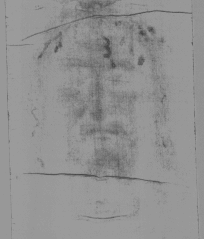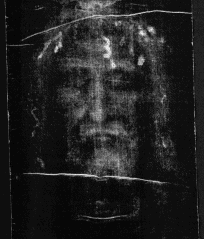|
The Shroud of Turin A bit of history... Ph. Dalleur |
|
The Shroud of Turin A bit of history... Ph. Dalleur |
See also the proposal for non-destructive experiments.
Short asserted history of the linen
In 1357, the Holy Shroud, presently venerated in Turin - Italy, appeared in the chapel of Lirey (1353) France, in the feoff of Geoffroy de Charny. A little piece of lead 5x3 cm² conserved at the "Musée de Cluny" in Paris, shows a representation of the Shroud just above the tomb of Jeanne de Vergy and her husband Geoffroy de Charny, which died in 1356: this archaeological piece is dated 1356-1370.
Henri de Poitiers, bishop of Troyes at this time, was not very glad with the apparition of this unidentified new relic in his diocese. In 1370, he prohibited every ostention (i.e. the so-called public exhibition). The Shroud was transferred at the Château de Montfort-en-Auxois until 1389, when the ostentions were allowed by a papal legate cardinal, consequently by the Pope Clement VII himself. The pilgrims were flowing but the second successor of Henri de Poitiers, bishop Pierre d'Arcis, wrote a protest to the Pope (it is worth to mentioned that the letter was not authenticated). In any case, the letter didn't reach the wanted effect: the Pope maintained the right for ostention to the canon of the Lirey collegial.
In 1418, with the Hundred Years War, the linen was secured at Count de la Roche, married to Marguerite de Charny. Marguerite refused to give the Shroud back to the canons in 1443. The dispute got worse and led to the excommunication of Marguerite in 1457. In fact, she needed titles or money, so that she had already given the linen to the duke of Savoie, Louis the 1st, in 1453. Because it was prohibited to buy or sell relics, the transaction was kept secret. Consequently, the holy Shroud is found in Geneva.
In 1471, the private relic of Savoie get recognition by Pope Sixte IV. Jules II linked indulgences to the worshipped relic. The Shroud was copied by several artists. In 1502, it was deposited in the chapel of the Château of Chambéry, folded in a silver reliquaire.
There it suffered a fire in 1532, which partly burnt the relic. A liquid silver drop went through it. Clariss nuns put some pieces to repair the linen. The Shroud was showed during several processions in the country. But in 1578 it was definitively transferred in Turin.
Its following history went without any major problem until 1898, when Secondo Pia, an italian advocate and amateur photograph, developed the very first photograph of the Shroud. The negative gave striking impression because of its greater and more realistic contrast.
 |
Compare the two photographs here. |
 |
In the ostention of 1931, Enrié took even more contrasted photographs.
The rest is modern history. In 1978, the STURP (Shroud of Turin Research Project) gathered a scientific team to deeply analyse the Shroud. Their results were amazing. Max Frei discovered pollens of Middle East origin on the linen. The anatomy analysis exhibits a yet unseen medical precision in other paintings. It does'nt seem to be a painting either. Nevertheless, nobody wanted to perform destructive experiments, like the C14 dating. The needed sample to correctly date the Shroud was already too great to be acceptable. But in 1979, Gove asked the permission to date the Shroud with the new C14 dating AMS method: the results were so widely spread that they were rejected. Ugolotti and Marastoni discovered several latin and greek inscriptions on the Shroud in 1980.
We have to wait until 1988 to get an agreement between the various sides over good protocols for C14 dating : the Catholic Church which received the Shroud from the Savoie family in 1983, the various laboratories, experts, procedure supervisers, etc. The measurements gave an age of about 700 years (d.C. 1260 to 1390). But the laboratories diverge quite a lot in their measurements, particularly the Oxford laboratory, and that especially for the Shroud samples. Actually they receive four samples of archaeological pieces, one of which was a Shroud sample, and the three others for confidence test. The significance level (S.L.), which measures the agreement between the results of the laboratories, is only 5% for the Shroud samples, which contrast greatly with the other three S.L. for the test samples (30%, 50% and 90%: see the issue 337 of Nature, feb. 1989, pp. 611-615 and our page of proposal for new experiments).
A Congress on the Shroud of Turin took place in Rome in 1993: several scientists evaluated the methods and protocols used to date with C14 AMS method, and they put in question certain results and interpretations.
In fact, during its restless history, the linen could have been enriched in its C14 content. The various cause of possible enrichment go from ion exchange by fire and heat (hot atmosphere rich in new carbon, with catalytic action of sliver traces, owing to Kouznetsov), contamination with dead or living organic matter present on the surface (the linen was worshipped by a lot of pilgrims, incensed, often manipulated, probably on the borders, contaminated by bacteria or moulds, etc.).
We also have artefacts which tell us about the existence of a Holy Shroud quite before the C14 AMS proposed date, (for example the Pray Codex dated 1150, as prof. Lejeune explained at the Rome Congress).
Between 1994 and 1996, the Institut d'Optique d'Orsay (with researchers A. Marion and A.-L. Courage) confirmed the presence of Greek and Latin inscriptions on the Shroud (nothing was written in old French as one could have expected).
In the first days of April 1997, the Turin cathedral suffered a great fire, which surely would have destroyed the Shroud, it was not for the firemen team of the city. 1998 was the 100th anniversary of the photograph made by Secondo Pia. Cardinal Saldarini declared the Shroud will be ostended this year and in the year 2000.
Is the Shroud of Turin the Mandylion?
Before the 14th century, we lose the trace of the Shroud of Turin, but various documents and representations seem to refer to it. Let us try to recall the supposed history of the Shroud of Jesus Christ. Several writings speak about the " Mandylion of Edess ". Even if history and legends seem to confuse, we can sum up the following history:
According to the account of the Gospels, Jesus of Nazareth died in Jerusalem, crucified after scourging, at the beginning of the first century, one Friday, the day before 14 nisàn (Easter in the Jewish calendar). Taht year, Jewish Easter was a shabbat: according to our calculations it must have been Friday April 7 of the year 30. The body wrapped of a shroud, was deposited in a new sepulchre, belonging to a rich Jew named Joseph, originating in Arimathie. Jesus could not have treated himself to such a shroud, which was of excellent quality. Jesus rested the shabbat in the tomb. Its body carried the traces of the torment: holes of nails to the hands and the feet, crowning of spines, scourging, as well as a perforation of Roman lance to the heart.
The testimony of the disciples is unanimous: Sunday, early the morning, Jesus ressuscites. The apostles observe the shroud, kept in position (perhaps dried blood and sweat maintained it according to the shape of the body), the strips rolled up apart. The Acts of the Apostles attest that Jesus still remained 40 days on the Earth before disappearing. It will only come back at the end of the current world.
The shroud seems to be recovered by the disciples of Jesus. But a used funeral linen was impure and has to be burnt. It was probably hidden initially. A legend tells that the king Abgar V of Edess (old city located in the south of current Turkey) being very sick, asked Jesus to cure him. He was asked to wait the sending of the shroud of Jesus, what he did. Having been cured by contact with the Holy Shroud, he converted himself during the year 35.
In 594, Evagre the Scholastic mentions the presence in Edess of the " Mandylion ", an image of Christ not made by hand of man ("archeiropoïete"). The representations of Christ (paintings) begin to ressemble the image of the Mandylion: the iconography of Christ changes and the Mandylion is thought to be the very Shroud of Jesus.
In 944, the Mandylion is transferred to Constantinople, where it is venerated like the Shroud of Jesus-Christ. The shroud, presumably kept folded, was probably unfolded at that time, thus revealing the whole crucified body.
Towards 1150, a miniature in the Codex of Pray represents the shroud of Christ (the Codex is now preserved in Budapest). The image of Christ is represented with several characteristics to be seen on the Shroud of Turin: hands without visible inches, arms crossed at the wrists level. The feet are not visible in front face. The shroud of the Codex is folded following the Jewish habit. The higher part shows Z structures comparable to the weaving twill of the flax fibers used in the Turin linen. The lower part represents a series of small crosses which ressemble the traces the crossed scourgings on the back and the legs of the man of Turin. Finally, a series of " L " shaped holes visible on the Shroud of Turin, are represented on the two faces of the Codex shroud (cfr. R. Van Haelst). These facts are so striking that they question the official C14 dating (which gives an origin between 1240 and 1340).
In 1204, the "Mandylion", preserved at Sancta Maria of Blachernes, disappears at the time of the sacking of Constantinople by the Crusaders, as stated by a picardian or walloon knight, chronicler of the 4th crusade, named Robert de Clary (the document preserved at the royal library of Copenhagen).
Some historians think the Mandylion has been taken by a crusader of noble family or a knight, or has been recovered by a military Order of Western Europe (like the Templiers in France for example). So they explain that this Mandylion can in fact be the shroud of Lirey, which became later the Shroud of Turin.
Additional information
Consult shroud.com to obtain complete information;
See also our page of proposal for nondestructive
experiments with the Shroud.
Others websites :
http://www.suaire-science.com
http://www.linceul.new.fr
Father Ph. Dalleur |